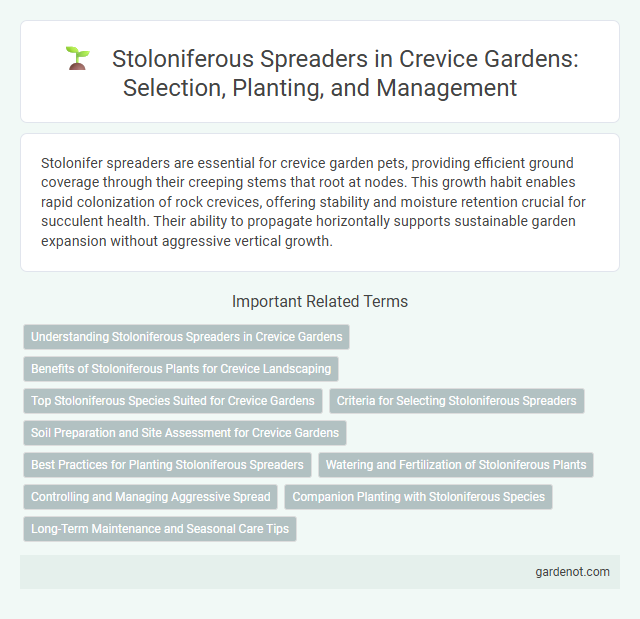Stolonifer spreaders are essential for crevice garden pets, providing efficient ground coverage through their creeping stems that root at nodes. This growth habit enables rapid colonization of rock crevices, offering stability and moisture retention crucial for succulent health. Their ability to propagate horizontally supports sustainable garden expansion without aggressive vertical growth.
Understanding Stoloniferous Spreaders in Crevice Gardens
Stoloniferous spreaders play a crucial role in crevice gardens by enabling plants to propagate horizontally through runners or stolons, anchoring themselves in narrow soil pockets. This growth habit enhances ground cover and plant density, effectively stabilizing the rocky substrate and promoting biodiversity. Understanding the mechanisms of stoloniferous spreaders helps gardeners optimize plant placement and improve overall crevice garden resilience.
Benefits of Stoloniferous Plants for Crevice Landscaping
Stoloniferous plants thrive in crevice gardens by spreading through horizontal stems called stolons, which anchor securely in narrow soil pockets and promote dense, ground-hugging growth. Their rapid propagation helps stabilize soil, prevent erosion, and fill gaps between rocks, enhancing the structural integrity and aesthetic appeal of crevice landscapes. These plants require minimal maintenance, demonstrate drought tolerance, and contribute to biodiversity, making them ideal for sustainable crevice garden designs.
Top Stoloniferous Species Suited for Crevice Gardens
Top stoloniferous species suited for crevice gardens include Fragaria vesca (wild strawberry), known for its vigorous stolon spread and low-growing habit that anchors in narrow rock fissures. Creeping thyme (Thymus serpyllum) thrives in well-drained crevices, producing dense mats through rapid stoloniferous growth, offering aromatic foliage and delicate blooms. Saxifraga stolonifera excels with its ability to send out stolons that root in shallow soil pockets, providing lush ground cover and attractive foliage ideal for rock garden crevices.
Criteria for Selecting Stoloniferous Spreaders
Selecting stoloniferous spreaders for crevice gardens requires evaluating factors such as adaptability to rocky, shallow soils and the ability to thrive in minimal nutrient environments. Plants should exhibit rapid horizontal growth through stolons to effectively cover crevices and stabilize soil without overwhelming neighboring species. Resistance to drought and temperature fluctuations ensures long-term survival and aesthetic appeal within the unique microhabitats of crevice gardens.
Soil Preparation and Site Assessment for Crevice Gardens
A stolonifer spreader requires well-drained, sandy or gritty soil with minimal organic matter to mimic alpine conditions ideal for crevice gardens. Conduct site assessment to ensure exposure to full sun and protection from excess moisture, as stolonifer species thrive in rocky, nutrient-poor substrates that prevent root rot. Proper soil preparation includes incorporating coarse sand or gravel to enhance drainage and replicate natural crevice environments essential for stolonifer growth.
Best Practices for Planting Stoloniferous Spreaders
Plant stoloniferous spreaders in well-drained, nutrient-rich soil to promote vigorous growth and prevent rot. Space plants adequately, typically 12 to 18 inches apart, allowing their runners (stolons) to extend and root naturally. Regularly monitor moisture levels, keeping the soil consistently moist but not waterlogged, to support healthy stolon development and prevent stress.
Watering and Fertilization of Stoloniferous Plants
Stoloniferous plants in crevice gardens require consistent watering to maintain moist, well-drained soil that supports their spreading stolons. Using a balanced, slow-release fertilizer with a nitrogen-phosphorus-potassium (NPK) ratio around 10-10-10 encourages healthy growth and promotes vigorous stolon development. Frequent monitoring of soil moisture and periodic feeding during the growing season ensures optimal hydration and nutrient availability for stolonifer spreaders.
Controlling and Managing Aggressive Spread
Stolonifer spreaders in crevice gardens require careful control to prevent aggressive spreading that can overwhelm other plants. Implementing physical barriers and frequent pruning helps manage stolon growth effectively, maintaining the garden's structural integrity and plant diversity. Regular monitoring ensures early detection of rapid expansion, allowing timely intervention to balance the ecosystem.
Companion Planting with Stoloniferous Species
Stolonifer spreaders thrive in crevice gardens by efficiently covering rocky gaps, creating a natural ground cover that stabilizes soil and prevents erosion. Companion planting with stoloniferous species like creeping thyme, strawberries, and certain sedums enhances biodiversity and supports pollinator attraction. This synergy promotes a resilient, low-maintenance garden ecosystem ideal for harsh, dry conditions found in crevice environments.
Long-Term Maintenance and Seasonal Care Tips
Stolonifer spreaders require consistent long-term maintenance to prevent overgrowth and ensure healthy propagation in crevice gardens. Seasonal care includes pruning runners during spring to promote dense ground cover and reducing spread in fall to prepare for winter dormancy. Regularly monitoring moisture levels and providing occasional fertilization enhances the spreader's vigor and longevity.
Stolonifer spreader Infographic

 gardenot.com
gardenot.com